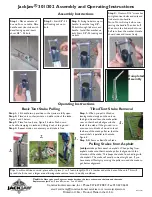
Page 101 of 112
NOTE
: High compliance tympanograms will take
somewhat longer.
Gradient:
226 Hz only
: Measurement of the tympanogram width
taken at 50% of peak compliance.
Acoustic Reflex Stimuli
F
requencies:
226 Hz Probe Tone:
500, 1000, 2000, and 4000 Hz for both
ipsilateral and contralateral stimulation
1000 Hz Probe Tone:
500, 2000 and 4000 Hz for both
ipsilateral and contralateral stimulation
Accuracy
:
±3%
Total Harmonic Distortion:
<5% for outputs less than 110 dBHL and <10% at 110
dBHL
Rise/Fall Time
:
5 to 10 msec
Transducers
IPSILATERAL:
GSI design
CONTRALATERAL:
Single Audiovox Model SM-N insert phone (Version 2 and 3 only)
Output Levels:
IPSILATERAL
:
For 226 Hz Probe Tone:
500 and 4000 Hz:
80, 90,100 db HL (Combo Probe design
@ 4000 Hz has 80 and 90 db HL only)
1000 and 2000 Hz:
85, 95, 105 dB HL
For 1000 Hz Probe Tone:
500 and 4000 Hz:
80 and 90 dBHL
2000 Hz:
85 and 95 dBHL
CONTRALATERAL
:
For 226 Hz Probe Tone:
500, 1000, 2000, 4000 Hz:
90, 100, 110 dB HL
For 1000 Hz Probe Tone:
500, 2000 and 4000 Hz:
90 and 100 dB HL
NOTES:
1.
226 Hz Probe Tone:
Ipsilateral stimuli are time multiplexed with
probe tone (93 ms ON, 66 ms OFF).
1000 Hz Probe Tone:
Ipsilateral stimuli are time multiplexed
with probe tone (62 ms ON, 62 ms OFF).
2.
Contralateral stimuli are steady tones.
3.
Stimuli are presented at lowest level first. If there is no
response, the intensity is increased by 10 dB until a response is
detected or the maximum dB HL is reached.












































